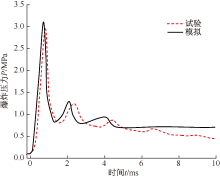| [1] |
翟成, 曲占庆, 邓守春, 等. 页岩储层甲烷原位燃爆压裂理论与技术研究进展[J]. 中国矿业大学学报, 2024, 53(3):435-455.
|
|
ZHAI Cheng, QU Zhanqing, DENG Shouchun, et al. Strategic conception and research progress of methane in-situ deflagration fracturing technology in shale reservoirs[J]. Journal of China University of Mining and Technology, 2024, 53(3):435-455.
|
| [2] |
翟成, 王宇, 刘厅, 等. 不同燃爆载荷作用下页岩破裂特性及孔裂隙结构改性规律[J]. 煤炭学报, 2023, 48(12):4269-4283.
|
|
ZHAI Cheng, WANG Yu, LIU Ting, et al. Fracture characteristics and pore structure evolution law of shale under different methane explosive fracturing loads[J]. Journal of Coal Science and Engineering, 2023, 48(12):4269-4283.
|
| [3] |
贾真真, 叶青, 杨卓华. 瓦斯爆炸冲击-地应力动静载荷下巷道壁面损伤特性[J]. 中国安全科学学报, 2024, 34(10):116-123.
|
|
JIA Zhenzhen, YE Qing, YANG Zhuohua. Damage characteristics of roadway wall under dynamic-static loads by gas explosion impact and geostress[J]. China Safety Science Journal, 2024, 34(10):116-123.
|
| [4] |
余旭, 王宇, 翟成, 等. 高温-动态冲击作用下页岩微纳米孔隙结构演化特征[J]. 中国安全科学学报, 2023, 33(10):137-146.
|
|
YU Xu, WANG Yu, ZHAI Cheng, et al. Evolutionary characteristics of shale micronano pore structures under high-temperature dynamic impact[J]. Journal of Safety Science and Technology, 2023, 33(10):137-146.
|
| [5] |
王宇, 翟成, 唐伟, 等. 循环冲击载荷作用下页岩动力学响应及能量耗散特征[J]. 爆炸与冲击, 2023, 43(6):76-89.
|
|
WANG Yu, ZHAI Cheng, TANG Wei, et al. Dynamic response and energy dissipation characteristics of shale under cyclic impact loadings[J]. Explosion and Shock Waves, 2023, 43(6):76-89.
|
| [6] |
牟恭雨, 罗宁, 申涛, 等. 聚能射流侵彻页岩储层损伤裂隙形成机制[J]. 爆炸与冲击, 2023, 43(3):85-101.
|
|
MU Gongyu, LUO Ning, SHEN Tao, et al. Mechanism of damage-induced fracture formation in shale reservoir penetrated by shaped charge jet[J]. Explosion and Shock Waves, 2023, 43(3):85-101.
|
| [7] |
李东传, 陈奕君, 邹雪岩. 聚能射孔对注聚影响试验研究[J]. 采油工程, 2022(4):58-61.
|
|
LI Dongchuan, CHEN Yijun, ZOU Xueyan. Experimental study on the effect of shaped charge perforating on polymer flooding[J]. Oil Production Engineering, 2022(4):58-61.
|
| [8] |
高岳, 王涛, 严子铭, 等. 页岩气高效开采中钻井完井和水力压裂的关键力学问题[J]. 力学学报, 2022, 54(8):2248-2268.
|
|
GAO Yue, WANG Tao, YAN Ziming, et al. Key mechanical problems of well drilling and completion and hydraulic fracture in highly efficient extraction of shale gas[J]. Chinese Journal of Theoretical and Applied Mechanics, 2022, 54(8):2248-2268.
|
| [9] |
GAO Yan, NG H D, LEE J H S. Minimum tube diameters for steady propagation of gaseous detonations[J]. Shock Waves, 2014, 24(4):447-454.
|
| [10] |
喻健良, 高远, 闫兴清, 等. 初始压力对爆轰波在管道内传播的影响[J]. 大连理工大学学报, 2014, 54(4):413-417.
|
|
YU Jianliang, GAO Yuan, YAN Xingqing, et al. Effect of initial pressure on propagation of detonation wave in round tube[J]. Journal of Dalian University of Technology, 2014, 54(4):413-417.
|
| [11] |
FAJ J A. Two-Dimensional gaseous detonations: velocity deficit[J]. Physics of Fluids, 1959, 2(3):283.
|
| [12] |
GAO Yan, ZHANG Bo, NG H D, et al. An experimental investigation of detonation limits in hydrogen-oxygen-argon mixtures[J]. International Journal of Hydrogen Energy, 2016, 41(14):6076-6083.
|
| [13] |
ZHANG Bo, LIU Hong, YAN Bingjian. Investigation on the detonation propagation limit criterion for methane-oxygen mixtures in tubes with different scales[J]. Fuel, 2019, 239:617-622.
|
| [14] |
WU Mingxun, WANG Chanyu. Reaction propagation modes in millimeter-scale tubes for ethylene/oxygen mixtures[J]. Proceedings of the Combustion Institute, 2011, 33(2):2287-2293.
|
| [15] |
PAN Zhenhua, QI Jun, PAN Jianfeng, et al. Fabrication of a helical detonation channel: effect of initial pressure on the detonation propagation modes of ethylene/oxygen mixtures[J]. Combustion and Flame, 2018, 192:1-9.
|
| [16] |
徐正坦. 流体力学[M]. 北京: 化学工业出版社, 2020:275.
|
| [17] |
胡斌斌. 小尺度管道中甲烷—氧气爆炸特性实验研究[D]. 北京: 北京理工大学, 2016.
|
|
HU Binbin. Experimental study on explosion characteristics of methane-oxygen in small scale pipeline[D]. Beijing: Beijing Institute of Technology, 2016.
|
| [18] |
曹小龙. 甲烷/气相助燃剂燃爆特性及其燃爆致裂页岩的机理研究[D]. 徐州: 中国矿业大学, 2023.
|
|
CAO Xiaolong. Research on explosion characteristics of methane/gaseous phase combustion promoters and mechanism of fracturing shale by explosion[D]. Xuzhou: China University of Mining and Technology, 2023.
|
| [19] |
|
| [20] |
YANG Zixin, YUE Ye, TAO Li, et al. Experimental study of DDT run-up distance and detonation wave velocity deficit for stoichiometric hydrogen-oxygen mixture in micro spiral channels[J]. International Journal of Hydrogen Energy, 2024, 49(2):253-263.
|
| [21] |
KITANO S, FUKAO M, SUSA A, et al. Spinning detonation and velocity deficit in small diameter tubes[J]. Proceedings of The Combustion Institute-PROC COMBUST INST, 2009, 32(2): 2355-2362.
|
| [22] |
YANG Zixin, YUE Ye, HUO Jiepeng, et al. Experimental investigation on the DDT run-up distance and propagation characteristics of detonation wave in a millimeter-scale spiral channel filled with hydrogen-air mixture[J]. International Journal of Hydrogen Energy, 2024, 51(2):713-726.
|
| [23] |
刘丹丹. 细管道中氢-空气混合物火焰加速与爆燃转爆轰数值模拟研究[D]. 合肥: 中国科学技术大学, 2022.
|
|
LIU Dandan. Numerical Simulation of flame acceleration and deflagration-to-detonation of hydrogen-air mixture in narrow channels[D]. Hefei: University of Science and Technology of China, 2022.
|
| [24] |
ZHANG Yang, ZHANG Qi. Flow process and energy release of hydrogen in fluorine[J]. International Journal of Hydrogen Energy, 2023, 48(5):2044-2054.
|
| [25] |
WANG Weijian, YE Qing, JIA Zhenzhen. Numerical investigation of dual-source gas explosion dynamics in h-type tunnels under varied enclosed situations[J]. Energy Science & Engineering, 2024, 12(11):15 078-15 091.
|
| [26] |
SMITH G P, GOLDEN D M, FRENKLACH M, et al. GRI-Mech 3.0[EB/OL]. [2024-06-10]. http://combustion.berkeley.edu/gri-mech/
|

























